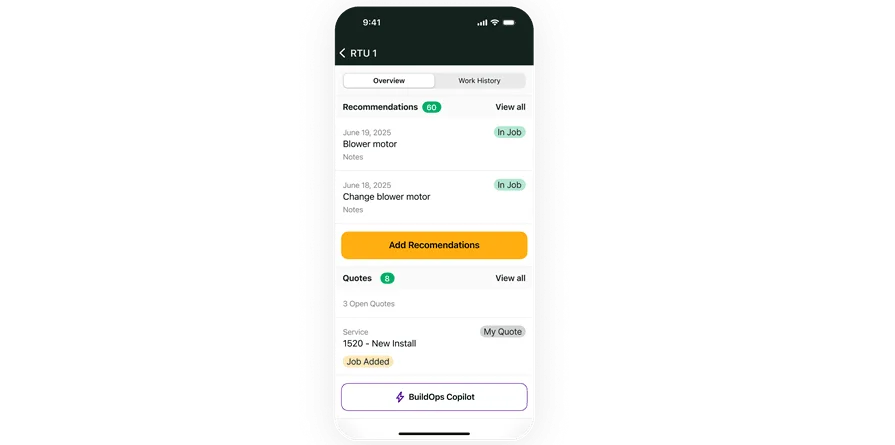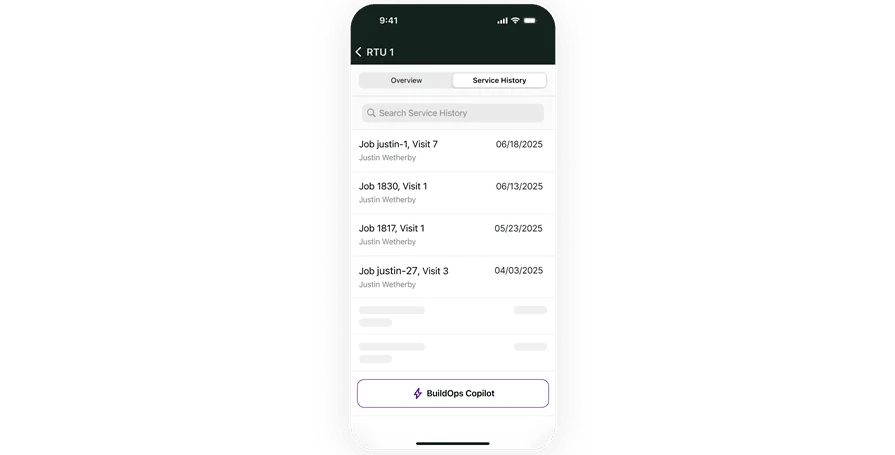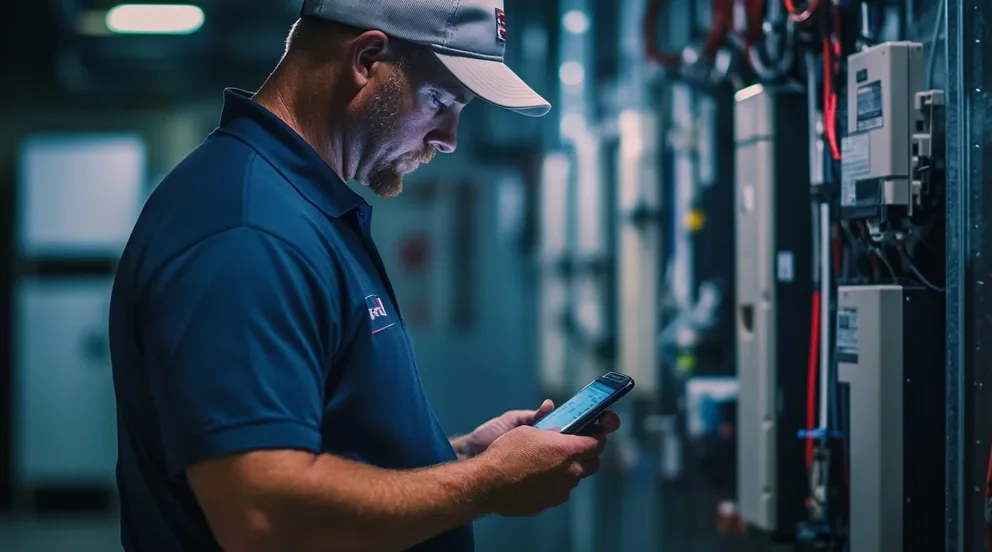Keeping electrical crews moving and jobs on schedule takes more than clipboards and call-ins. You need a tool that puts every detail—site info, materials, updates—right in your crew’s hands. That’s where a good electrical work order app comes in. From quick service calls to multi-day installs, the right app keeps techs connected, jobs organized, and work orders flowing without confusion. For contractors in the electrical industry, finding an app that matches field demands isn’t just helpful—it’s essential. In this guide, we’ll cover:
- Choosing the right electrical work order app for your team
- 5 key features to get in an electrical work order app
- 6 best electrical work order apps for contractors and field teams
- 7 benefits of using an electrical work order app
- 4 important FAQs about electrical work order apps answered
Before locking into a tool, you need to know what your techs really need to get the job done. From scheduling to invoicing, here’s how to evaluate the best electrical work order app for your crew.
Choosing the right electrical work order app for your team
Before adding a new app to your team’s toolbox, take a step back and think about what your techs actually need to get the job done right. Electrical contractors don’t have time for clunky menus or overcomplicated features—they need fast access to job info, circuit details, and task updates without missing a beat. Whether you’re handling panel installs, running conduit, or responding to urgent power issues, your electrical work order app should work just as hard as your crew in the field. Here’s what to look for:
- Layout – Is the interface clean and easy for techs to use in the field? Can they quickly see schedules, addresses, or material lists without digging around? Does it show them what they need right when they open it?
- Simplicity – Can your crew close out a job, log notes, or update a status in seconds? Does the app cut down on taps and steps, or are you adding friction to their workflow?
- Job info access – Can techs see everything from panel specs to site notes in one place? Does the app include circuit diagrams, inspection checklists, or device counts without needing to call the office?
- Communication tools – Does the app allow field teams to report issues, send updates, or ask for support in real time? Can they flag wiring conflicts or material shortages without switching to another app?
- Features – Can the app handle the full lifecycle of a work order—assignments, time logs, parts used, and invoicing? Does it work whether you're running scheduled maintenance or solving emergency outages?
With these filters in place, you’ll be in a much better position to choose an electrical work order app that keeps your field crew efficient and your operations running clean. Up next, we’ll break down the essential features the top apps need to include to support electrical contractors in the field.
5 key features to get in an electrical work order app
Managing crews across commercial properties, tenant spaces, and service calls doesn’t work without precision. The best electrical work order app gives you more than task management—it keeps every job detail, crew update, and customer handoff aligned from start to finish.
These five features are essential for electrical contractors looking to streamline field execution without sacrificing visibility or control.
1. Real-time scheduling and dispatching
Every job starts with knowing who’s going where—and when. The best electrical work order apps combine field service scheduling with dispatching software to give you full control over daily assignments. Your office team can view job progress, reroute techs, and fill schedule gaps in seconds.
Say you’ve got a tech replacing panels at a commercial site and another crew gets delayed on a service upgrade across town. With the app, you shift schedules in real time, reassign the closest available electrician, and avoid downtime—without playing phone tag or scrambling through spreadsheets.
2. Service agreement tracking
Recurring work like preventive maintenance, quarterly inspections, or annual testing should never fall through the cracks. An electrical work order app with service agreement tracking helps you monitor contract terms, visit history, and upcoming tasks all in one place.
Think about a property manager with five apartment buildings under a maintenance plan. A tech on-site pulls up the agreement from their phone, sees that a panel torque check is due, and adds it to the current visit without needing a callback from dispatch.
3. Time tracking per tech and task
Time tracking is essential when every job, big or small, impacts your bottom line. A good electrical work order app lets techs log hours by task in real time—whether they’re on a multi-day install or knocking out same-day service tickets. No more chasing paper logs or guessing who was where and for how long.
Say you’re running a two-person crew for a tenant improvement project. One tech spends most of the day on rough-in work, while the other handles trim-outs and testing. With time tracked by activity, you can bill accurately, evaluate productivity, and adjust labor plans for future jobs.
4. Job-based invoicing and payment collection
Work gets done faster when billing doesn’t slow you down. The best electrical work order apps tie invoicing and payment processing directly to each job, so techs can close out and collect before leaving the property.
Picture a tech completing an emergency service call at a grocery store after a breaker failure. With the app, they mark the job complete, generate the invoice from logged time and parts, and accept a card payment on the spot—no need to follow up or invoice later.
5. Job performance and reporting insights
A strong electrical work order app doesn’t just capture job details—it helps you learn from them. With reporting tools, you can track job durations, close-out rates, labor costs, and issue frequency across your entire operation. It turns daily work into data that actually drives decisions.
Let’s say two crews handle similar retrofit jobs in different zones. Reports show one team is consistently logging longer hours and more callbacks. You dig in, spot the hang-up—delays caused by inconsistent material drop-offs—and fix it by staging inventory ahead of time. That’s real impact from real numbers.
Other notable features for electrical work order apps
While scheduling, dispatching, mobile access, invoicing, and reporting carry the bulk of day-to-day field operations, a few additional features can level up how your electrical work order app supports your team. These tools aren’t must-haves for every crew, but they’re useful add-ons that can tighten workflows, improve customer experience, or help you scale without adding complexity.
- Customer relationship tracking (CRM) - A construction CRM keeps client history, contact info, and communication records in one place. It’s especially helpful for managing recurring accounts or long-term commercial clients with multiple properties and contacts.
- Proposal and quote creation - Built-in quoting tools make it easier to send work estimates straight from the field. Instead of bouncing between tools, techs or office staff can turn a quote into a work order as soon as the client signs off.
- Sales pipeline visibility - Tracking leads and upcoming bids with a sales pipeline tool can help you keep your backlog full without relying on sticky notes or memory. You’ll see where each opportunity stands and what’s ready to convert into an active job.
- Fleet visibility and management - Fleet tracking shows where your vehicles are, how long they’ve been on-site, and whether they’re due for service. It’s especially valuable when juggling multiple crews across city zones or job sites.
These additional features aren’t the backbone of your workflow, but they give your electrical work order app more depth—and help your team stay sharp as operations grow. Ready for the next section? Let’s dive into the top app options out there.
6 best electrical work order apps for contractors and field teams
Electrical work takes place in real-world conditions—not from behind a desk. The best electrical work order apps give your team what they need in the field: live job updates, accurate task details, and fewer delays between scheduling, dispatch, and completion.
These six apps help electricians stay productive by putting work order management, customer communication, and job tracking all in one place. Whether you’re managing service calls, installs, or maintenance routes, these tools are worth a closer look.
1. Best for commercial contractors: BuildOps
BuildOps is built specifically for commercial electrical contractors. It brings scheduling, dispatch, job tracking, invoicing, and customer history into one powerful system. Techs see job updates in real time, while the office has full visibility into open work orders, project progress, and technician availability. For teams managing complex builds, service calls, and recurring maintenance across multiple properties, BuildOps handles it all.
App Type: All-in-one field service management platform for electrical contractors
How Pricing Works: BuildOps offers guided demos and works with contractors to design a pricing plan based on business size and needs
Features Beyond Work Order Software: Real-time scheduling, dispatch intelligence, quoting tools, CRM, and robust analytics
What Sets It Apart for Commercial: Built for scale—multi-property scheduling, advanced field visibility, and a dashboard that actually helps you manage

Take a closer look at BuildOps
We help electrical contractors manage work orders, quotes, and invoicing.
2. Best for residential: Kickserv
Image Source: Kickserv
Kickserv is aimed at small residential contractors, offering a clean interface with easy scheduling, invoicing, and customer records. It’s a good fit for electricians handling smaller home service jobs where workflow simplicity is key. However, if you’re running crews across multiple locations or dealing with complex commercial tasks, its toolset may feel limited.
App Type: Service management platform for residential contractors
How Pricing Works: Subscription-based pricing with tiered feature access
Features Beyond Work Order Software: Customer management, scheduling, invoicing, estimates, and basic payment collection
What Sets It Apart for Residential: The homeowner-focused “Customer Center” lets clients view job history, approve work, and request service from a portal
3. Best for general contractors: Sera
Image Source: Sera
Sera delivers automation and financial visibility with tools for scheduling, job costing, and profitability tracking. Its structured workflows work well for general contractors managing various service types across different trades. That said, it lacks deep customization for electrical-specific field service tasks, which may not meet the hands-on needs of many electrical contractors.
App Type: Service management software built for profitability
How Pricing Works: Tiered pricing with a focus on value-based workflows
Features Beyond Work Order Software: Real-time job costing, scheduling tools, technician performance tracking
What Sets It Apart for General: Its automation-first approach gives GCs a clean dashboard and performance view, built around margins
4. Best for automation-focused teams: FieldPulse
Image Source: FieldPulse
FieldPulse targets contractors who want automated workflows for quoting, scheduling, and job status updates. The app gives you centralized job tracking and integrates invoicing, estimates, and communication tools all in one dashboard. It’s suitable for growing electrical businesses looking to reduce admin time—but its interface may feel limiting for teams handling larger commercial workloads or needing deeper field customization.
App Type: Service business management platform with automation tools
How Pricing Works: Custom pricing based on feature usage and business size
Features Beyond Work Order Software: Quote-to-job conversion, text communication with clients, customer records, digital payment tools
What Sets It Apart for Automation: Workflow triggers that update job status or customer communication automatically, helping teams reduce touchpoints
5. Best for small electrical teams: Jobber
Image Source: Jobber
Jobber is a well-known tool for field service management, with work order scheduling, invoicing, and job tracking all included. It’s especially useful for small-to-midsize electrical shops managing recurring clients and basic installs. However, it lacks some of the electrical-specific detail tracking or multi-property depth that larger contractors might expect from a fully integrated electrical work order app.
App Type: Contractor management platform for smaller field service teams
How Pricing Works: Tiered monthly subscription with optional add-ons
Features Beyond Work Order Software: Calendar-based scheduling, quoting, invoicing, client hub, limited automation features
What Sets It Apart for Simplicity: Its streamlined design makes it easy for smaller teams to get started quickly with minimal onboarding
6. Best for enterprise-level ops: ServiceTitan
Image Source: ServiceTitan
ServiceTitan is designed for large-scale service businesses managing high call volume, complex job data, and large teams. It includes tools for estimating, dispatch, CRM, and reporting—built to support operations at scale. While powerful, its learning curve and pricing may be too much for smaller electrical shops or those focused strictly on field execution.
App Type: Enterprise field service management software
How Pricing Works: Custom pricing plans for larger operations
Features Beyond Work Order Software: Advanced analytics, call booking, inventory management, GPS tracking, robust CRM tools
What Sets It Apart for Scale: Built for enterprise use, with tools designed to coordinate multi-crew, high-volume service departments across regions

Get the Electrical Contractor Toolkit
Access leading strategies, pre-built templates, and real-life examples.
7 benefits of using an electrical work order app
A dependable electrical work order app doesn’t just manage job tickets—it supports how electricians move through their day. It helps cut delays, reduce errors, and simplify the way work gets done in the field and in the office. Here’s how the right setup pays off across your operation.
1. Faster job turnaround
When field techs don’t have to wait on calls, paperwork, or last-minute updates, jobs wrap quicker. With real-time job info and location-based scheduling, crews hit more stops per day without sacrificing quality. For teams managing multi-site commercial work, these scheduling efficiencies often come from the way the electrical work order app ties into their electrical contractor scheduling system, helping keep routes tight and start times clear.
2. Cleaner, on-the-spot invoicing
Instead of waiting until the end of the week to invoice or chasing down missing details, techs can create accurate invoices right after completing a task. This keeps billing aligned with job data and helps avoid delays in payment. For contractors working across service calls, installs, and change orders, this workflow often builds directly off the electrical work order app’s connection to how invoicing is handled in an electrical contractor billing process.
3. Fewer scheduling mix-ups
When job changes come at midday—whether it’s a no-show, a call-in, or a last-minute priority—the app helps dispatchers reassign work quickly without skipping a beat. Everyone stays updated in real time, avoiding crossed wires or double-booked crews. This kind of visibility is why electrical contractors often turn to dispatching tools tailored for electrical teams as part of their work order setup.
4. Better customer relationships
Consistency matters. When your techs show up knowing the customer’s history, previous issues, and contact preferences, it shows professionalism and builds trust. That kind of context often pulls from customer data that’s already linked inside the electrical work order app, which in many setups draws from a centralized CRM used by electrical contractors.
5. Smoother estimates and quicker approvals
Jobs don’t always go according to plan. Whether a client adds work mid-visit or the scope shifts during inspection, being able to quote from the field helps keep the job moving. Many electrical work order apps allow for quick estimates to be created directly within the same system, often integrated with the company’s bidding and proposal tools for electrical work so techs can stay focused on work—not chasing approvals.
6. Fewer back-and-forth calls between field and office
When the app keeps job data, parts used, and time logged all in one place, techs don’t need to call in for updates—and office staff don’t need to chase down paperwork. The reduction in calls and missed info improves flow on both sides. It creates a cleaner, quieter job cycle with fewer slowdowns across the board.
7. Less paperwork, fewer errors
Digital work orders cut out handwritten notes and manual reentry, two of the most common places where errors creep in. Everything’s tracked—timestamps, materials, job notes—and synced back to the system. That means no more guessing what happened on-site or digging through folders to confirm the details.
4 important FAQs about electrical work order apps answered
If you’re running field crews, managing quotes, and juggling service calls, the electrical work order app you choose becomes the backbone of your operation. For electricians, that app needs to work just as well in the field as it does in the office—speeding up communication, cutting down paperwork, and keeping everyone on the same page.
Below are a few questions electricians often ask when evaluating which app fits best.
1. What is an electrical work order app?
Electrical work order apps help contractors manage service jobs in the field. It centralizes job details—like schedules, customer information, work instructions, and materials—into one platform. These tools reduce delays, improve team coordination, and help ensure jobs get completed correctly the first time.
2. How does an electrical work order app work?
The app connects your office and field teams in real time. Dispatchers assign jobs, techs receive updates instantly, and invoices or quotes can be sent directly from the field. As jobs progress, everyone sees the same updates, keeping both techs and back-office staff aligned on what’s done, what’s next, and what needs attention.
3. Who needs an electrical work order app?
Any electrical contracting business that sends crews into the field will benefit from a work order app. Whether you're handling single-day installs, service calls, or managing a larger commercial operation, the app gives techs access to schedules, job history, and documentation—so they can get the job done without checking back with the office constantly.
4. What are the best practices to follow when implementing an electrical work order app?
Rolling out a new tool takes more than just downloading the software. The transition works best when you lay the groundwork ahead of time and build habits that stick. Below are 10 smart practices electrical contractors should keep in mind when adopting a new app for managing work orders.
- Involve both field and office teams early in the selection process
- Start with a phased rollout—don’t push full adoption all at once
- Set clear goals for what the app should improve (scheduling speed, fewer invoicing delays, etc.)
- Offer hands-on training with actual work orders, not just demo data
- Assign an internal point person to lead the transition
- Audit existing workflows and adjust them to fit the new system
- Make sure your app works on all devices your team uses—especially in the field
- Keep communication open—get regular feedback from techs and dispatchers
- Use reporting tools to track early wins and areas for improvement
- Stick with it—most teams need a few weeks to settle into new habits
Picking the best electrical work order app comes down to one thing: making life easier for your crew. The smoother the handoffs between office and field, the faster jobs get done—and the fewer mistakes you deal with later. Whether it’s a service call, a panel upgrade, or a multi-day install, the right app keeps your team focused, informed, and moving without the usual back-and-forth.
For electrical contractors managing high volumes of field work, using an all-in-one field service management platform like BuildOps brings every piece of the job together. Dispatch, scheduling, quoting, time tracking, and invoicing all live in one system—so nothing gets missed, and your team stays connected from start to finish.

Curious to see how BuildOps works?
We help electrical contractors run tighter, cleaner jobs—without the guesswork.








